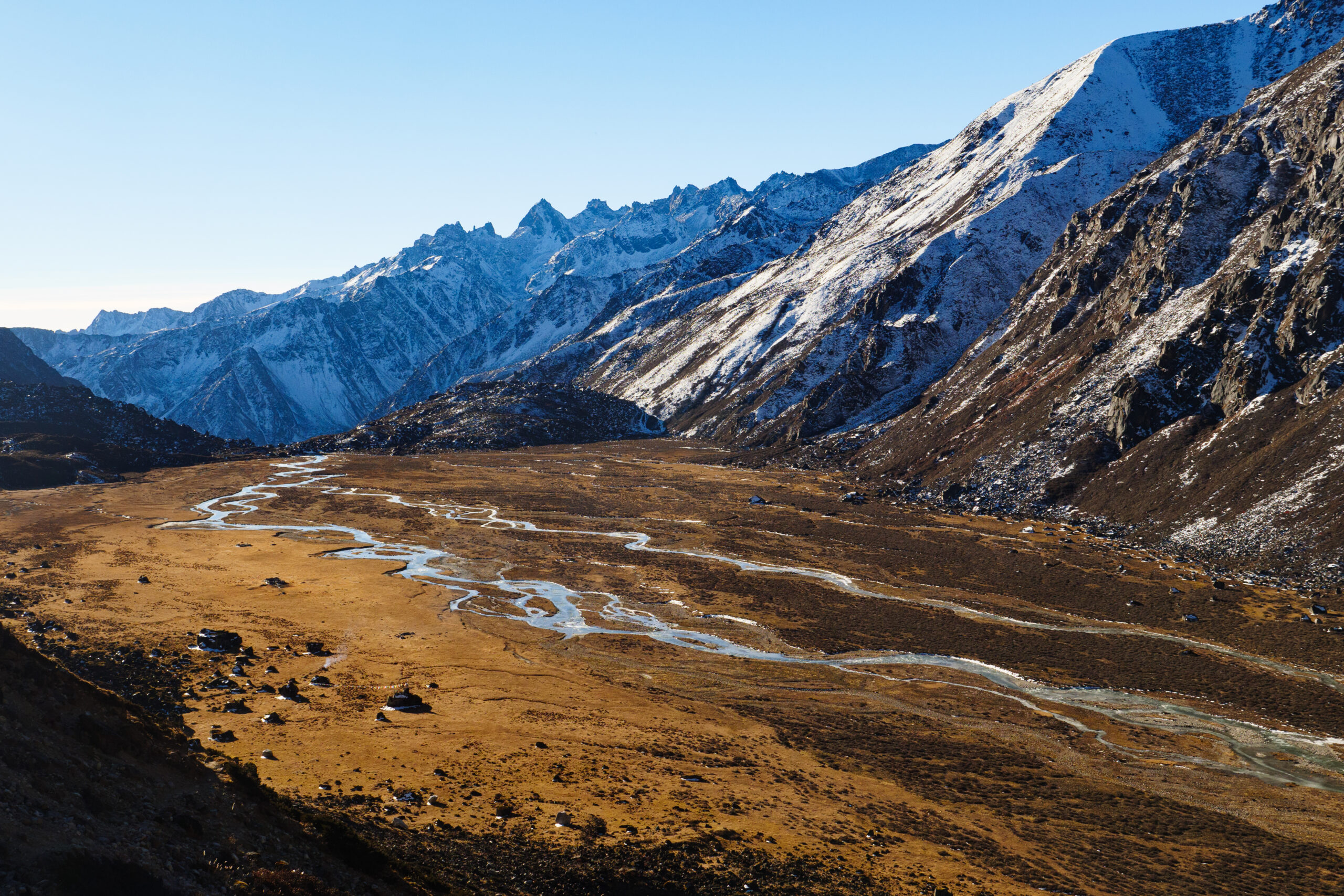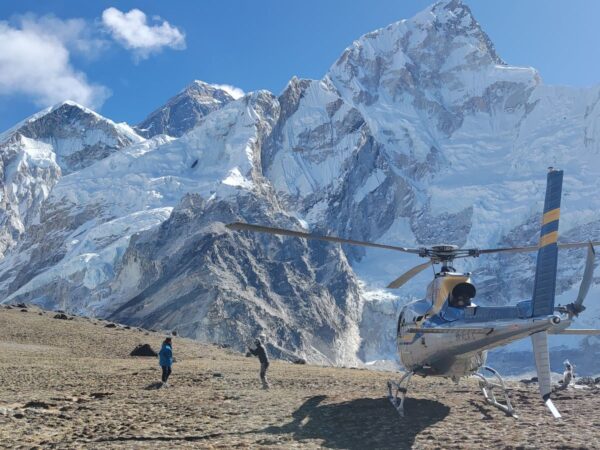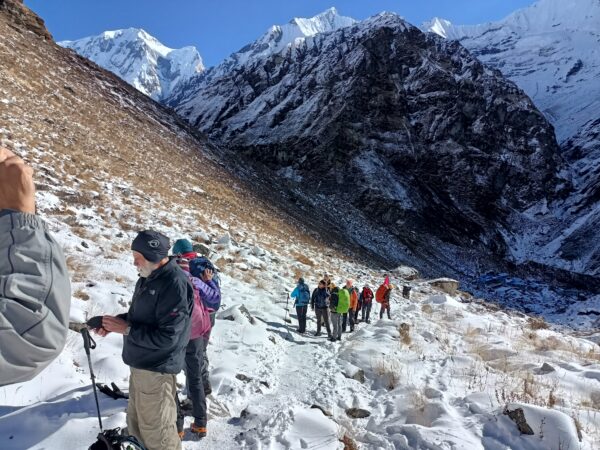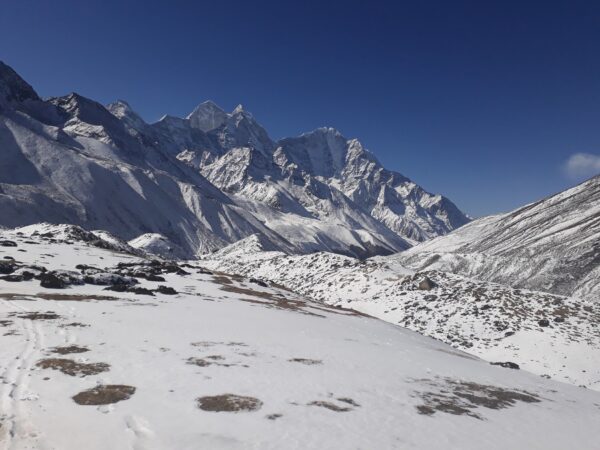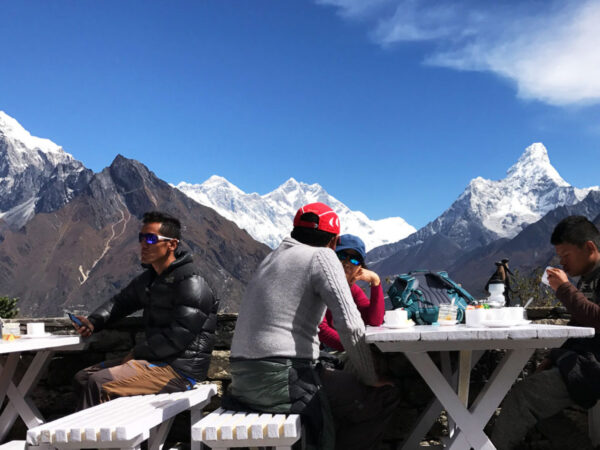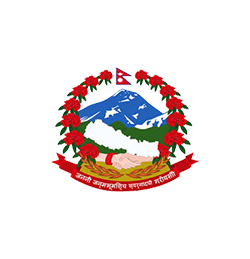Highlights
- Follow the historic route to Everest used by early mountaineers.
- Encounter rare Himalayan wildlife, including Red Pandas and Snow Leopards.
- Explore isolated villages like Olangchung Gola and Thudam.
- Marvel at breathtaking views of Kanchenjunga, Makalu, and Mount Kumbakarna.
- Cross the stunning Lumba Sumba Pass at 5,160m, one of Nepal’s least explored passes.
- Immerse in the rich culture and traditions of Sherpa, Rai, and Limbu communities.
Overview
The Lumba Sumba Pass Trek is a challenging and rewarding journey that connects the Kanchenjunga Conservation Area and Makalu Barun National Park in eastern Nepal. First explored in 2012, this trek offers an immersive experience through diverse landscapes, from subtropical forests to alpine terrains. Trekkers traverse high mountain passes, including the notable Lumba Sumba Pass at 5,160 meters, and encounter a rich array of flora and fauna, such as the elusive snow leopard and red panda. The route also provides cultural insights into the traditions of local communities, including the Limbus, Rai, Sherpas, Magars, and Tamang. Highlights of the trek include the Nanga La Pass, the Tamor and Arun river systems, and panoramic views of towering peaks like Kanchenjunga and Makalu. This 20-day adventure along a segment of the Great Himalayan Trail is ideal for those seeking both natural beauty and cultural richness in a less-traveled part of Nepal.
Best Time to Lumba Sumba Pass Trek
The Lumba Sumba Pass Trek is a challenging and rewarding journey that connects the Kanchenjunga Conservation Area, home to the world’s third-highest peak, Kanchenjunga (8,598 meters), with the Makalu Barun National Park, which houses the fifth-highest peak, Makalu (8,485 meters). First explored in 2012, this trek offers an immersive wilderness experience along the Great Himalayan Trail.
Spanning approximately 20 days, the trek begins in subtropical regions and ascends to alpine terrains, presenting trekkers with diverse challenges, including traversing high mountain passes, navigating untamed environments, and exploring isolated valleys. The route is rich in biodiversity, with opportunities to encounter rare wildlife such as snow leopards and red pandas.
A highlight of the journey is the crossing of the Lumba Sumba Pass at an elevation of 5,160 meters, offering breathtaking landscapes and topographical diversity. The trek also features the Nanga La Pass and follows the Tamor and Arun river systems, major tributaries of the Sapta Koshi River. Trekkers will traverse alpine grasslands, rocky outcrops, dense temperate and subtropical forests, and low river valleys.
Beyond its natural allure, the trek provides cultural insights into the lives of various ethnic groups, including the Limbus, Rai, Sherpas, Magars, and Tamang. Along the way, trekkers will encounter monasteries, chortens, temples, prayer flags, and walls, enriching the journey with spiritual significance.
The optimal times for the Lumba Sumba Pass Trek are during the spring (March to May) and autumn (September to November) seasons. These periods offer stable weather conditions, clear skies, and moderate temperatures, enhancing the trekking experience. During spring, the trails are adorned with blooming rhododendrons and lush greenery, while autumn provides crisp air and unobstructed mountain vistas.
Embarking on the Lumba Sumba Pass Trek promises an unparalleled adventure, combining the thrill of high-altitude trekking with the serenity of Nepal’s diverse ecosystems and rich cultural tapestry.
Accommodation During the Lumba Sumba Pass Trek
The Lumba Sumba Pass Trek is primarily a camping trek due to the remoteness of the region. Along the trail, trekkers stay in tents, with a dedicated kitchen crew preparing meals. The food includes a mix of rice, lentils, vegetables, noodles, pasta, dumplings, and local bread, ensuring a balanced diet for high-altitude trekking. While some basic tea houses may be available in certain villages, they offer minimal facilities, making camping the primary accommodation option.
Since the trek passes through isolated areas, carrying extra snacks like energy bars, nuts, and dried fruits is recommended. In lower regions, fresh vegetables may be available, but as the altitude increases, food supplies become more limited. Drinking water is mainly sourced from natural streams, so using water purification tablets or filters is necessary. The overall experience provides a raw and immersive adventure into Nepal’s wilderness, combining challenging terrain with breathtaking landscapes.
Outline Itinerary for Lumba Sumba Pass Trek
Day 1: Arrival in Kathmandu (1,400m)
Day 2: Sightseeing in Kathmandu (1,400m)
Day 3: Fly to Bhadrapur & scenic drive to Taplejung (1,820m, 8-9 hrs)
Day 4: Trek to Chiruwa (1,270m, 6-7 hrs)
Day 5: Trek to Lelep (1,750m, 6-7 hrs)
Day 6: Trek to Ila Danda (2,050m, 5-6 hrs)
Day 7: Trek to Selep Kharka (2,525m, 6-7 hrs)
Day 8: Trek to Olangchung Gola (3,200m, 5-6 hrs)
Day 9: Trek to Upper Langmale (3,890m, 6-7 hrs)
Day 10: Trek to Pass Camp (4,750m, 5-6 hrs)
Day 11: Trek to Chauri Kharka via Lumba Sumba Pass (5,160m at the pass / 4,200m at Chauri Kharka, 7-8 hrs)
Day 12: Trek to Thudam (3,500m, 6-7 hrs)
Day 13: Trek to Yak Kharka (2,800m, 6-7 hrs)
Day 14: Trek to Chyamtang (2,200m, 6-7 hrs)
Day 15: Trek to Hatiya (1,600m, 5-6 hrs)
Day 16: Trek to Gola (1,128m, 5-6 hrs)
Day 17: Trek to Hedanga Gadhi (1,180m, 6-7 hrs)
Day 18: Trek to Num & drive to Tumlingtar (1,560m at Num / 400m at Tumlingtar, 7-8 hrs)
Day 19: Flight to Kathmandu (1,400m, 50 min)
Day 20: Departure from Kathmandu
Lumba Sumba Pass Trek – 20 Days - Itinerary
Arrival in Kathmandu (1,400m)
Upon landing at Tribhuvan International Airport in Kathmandu, a representative from Himalayan Trekkers will welcome you. You will then be transferred to your hotel, where you can complete the check-in process and take some time to relax. Once you are refreshed, a short briefing session about the Lumba Sumba Pass Trek will be conducted in the hotel lobby, providing essential details for the journey ahead.
If you arrive by noon and feel energetic, you can explore the vibrant streets of Thamel. This walk introduces you to the local culture, bustling markets, and numerous small Hindu and Buddhist temples, shrines, and stupas. Alternatively, a half-day sightseeing tour can be arranged, allowing you to visit one or two UNESCO-listed heritage sites in Kathmandu, depending on your interest and available time.
Sightseeing in Kathmandu (1,400m)
Your sightseeing tour begins with a visit to Boudhanath Stupa, one of Nepal’s largest Buddhist stupas. This massive dome-shaped structure, surrounded by prayer wheels and monasteries, is a vibrant yet peaceful site where monks and devotees perform kora (circumambulation). The area is filled with the aroma of incense, colorful prayer flags, and small shops selling traditional handicrafts.
Next, you’ll visit Pashupatinath Temple, a sacred Hindu site dedicated to Lord Shiva. The temple complex houses numerous shrines and monuments, with the main temple accessible only to Hindus. Along the Bagmati River, you may witness traditional cremation ceremonies. After exploring these heritage sites, you’ll return to Thamel for any last-minute trek preparations.
Fly to Bhadrapur & scenic drive to Taplejung (1,820m, 8-9 hrs)
You will take an early morning flight from Kathmandu to Bhadrapur, a 45-minute journey offering scenic aerial views of Nepal’s diverse landscapes. Upon landing at Bhadrapur Airport, you will meet your trekking crew and begin a drive towards Taplejung. The road trip passes through picturesque hills, lush tea gardens of Kanyan and Fikkal in Ilam, and charming villages, gradually leading to the black cardamom-producing region of Taplejung.
Taplejung, known for its vast cardamom forests, offers a refreshing stop before the trek begins. You will settle into a local guesthouse and rest for the night. In case of flight delays, an overnight stay in Bhadrapur will be arranged, and the drive to Taplejung will take place the following morning.
Trek to Chiruwa (1,270m, 6-7 hrs)
The trek officially begins as you follow the Tamor River, passing through scenic landscapes on the way to Furumba. The trail involves a mix of moderate walks, ascents, and descents, leading to Siwa Bazaar. Continuing uphill, you reach the Kanchenjunga Conservation Area checkpoint before gradually descending towards Chiruwa.
Chiruwa is known for its fertile land and abundant freshwater sources, making it an important agricultural hub in the valley. After a 5-6 hour trek, you will settle in and appreciate the natural beauty of this charming village.
Trek to Lelep (1,750m, 6-7 hrs)
The trek continues alongside the powerful Tamor River, passing two large stones considered sacred. The trail winds through lush Ulnas trees and scenic cardamom gardens, leading to Tapethok after about two and a half hours. This small market area offers local tea shops, providing a perfect place to rest.
After crossing the checkpoint, the trail ascends towards Lelep, the location of the Kanchenjunga Conservation Area headquarters. Upon arrival, you can explore the area, refresh yourself, and visit nearby grocery stores and tea shops for a relaxing break.
Trek to Ila Danda (2,050m, 5-6 hrs)
After breakfast, the trek continues through a dense forest, home to various wildlife species, including the elusive snow leopard. The trail crosses a scenic suspension bridge before ascending through a serene pine forest, leading to a monastery. After a brief visit and rest, the descent begins toward Gowatar, a small village settlement.
A short walk from Gowatar brings you to a stunning viewpoint showcasing two towering waterfalls, each about 100 meters high. After admiring the view, the trail crosses the Tamor River and reaches Chautaroo, a traditional resting spot. Another half-hour walk leads to Ila Danda, offering breathtaking views of snow-capped peaks. The night is spent at a tented camp.
Trek to Selep Kharka (2,525m, 6-7 hrs)
After breakfast, the trek continues through a lush rhododendron forest, leading to a suspension bridge after an hour of walking. Beyond the bridge, the trail enters a dense bamboo forest, known as a habitat for the elusive Red Panda. With some luck, you might catch a glimpse of this rare species.
After trekking for about three and a half hours, the trail reaches Maguwa, passing through serene maple and Ulnus forests. Another hour of walking through the peaceful woods brings us to our campsite for the night, where we settle in for an overnight stay at a tented camp.
Trek to Olangchung Gola (3,200m, 5-6 hrs)
After an early breakfast, we follow the trail along the Tamor River towards Jongim, a scenic flatland surrounded by snowcapped hills. The path takes us through a dense rhododendron forest and across a suspension bridge. A steady uphill climb for about an hour brings us to Ramite, where we pass through a mixed forest of Deodar and rhododendron.
Continuing for another hour, we come across a stunning waterfall before trekking for 45 more minutes to catch a distant view of the picturesque Olangchung Gola village. Upon arrival, we explore the historic monastery with its golden manuscript and visit the KCAP office. This beautiful Sherpa village offers a rich cultural experience. Overnight stay at a tented camp.
Trek to Upper Langmale (3,890m, 6-7 hrs)
After breakfast, we begin our trek through the remote wilderness, following stone cairns that serve as natural signposts along the trail. The route takes us through dense pine and rhododendron forests, offering a serene trekking experience.
After trekking for about two and a half hours, we reach Jadak, where we take a short break before continuing on a snowy path toward our destination. The journey through the untouched landscape provides a true sense of adventure. Overnight stay at a tented camp.
Trek to Pass Camp (4,750m, 5-6 hrs)
Today's trek follows the Tamor River, with a dense rhododendron forest visible on the opposite side. The trail offers a peaceful and scenic journey through the wilderness.
After trekking for about three hours, we arrive at Tangchetar, where we take a short break. Continuing for another three hours, we reach our campsite for the night. Overnight stay at a tented camp.
Trek to Chauri Kharka via Lumba Sumba Pass (5,160m at the pass / 4,200m at Chauri Kharka, 7-8 hrs)
Today is an exciting and challenging day as we make our way to the Lumba Sumba Pass (5,177m). The trail involves both ascents and descents, requiring steady pacing and proper hydration to tackle the altitude. We carry a packed lunch for the journey.
After approximately five hours of trekking from the pass camp, we reach the breathtaking Lumba Sumba Pass. After taking in the stunning views, we begin our descent toward Chaurikharka, where we settle for the night. Overnight stay at a tented camp.
Trek to Thudam (3,500m, 6-7 hrs)
After breakfast, we begin our descent toward Thudam, leaving behind the complete wilderness and gradually entering inhabited areas. After trekking for about three and a half hours, we reach Dobato, a junction where one trail leads to Lyasha in Tibet and the other to our destination.
Continuing on our path, we traverse rugged terrain and scenic landscapes until we arrive at Thudam, a remote village where we will spend the night. Overnight stay at a tented camp
Trek to Yak Kharka (2,800m, 6-7 hrs)
Today's trek follows the Chujung Khola, offering breathtaking panoramic views of the Makalu range. The trail winds through small bushes and bamboo groves, a habitat known for the endangered Red Panda. If lucky, you may spot one grazing in the bamboo thickets.
Water sources are scarce along the route, so carrying a full water bottle is essential. After six hours of trekking through dense forests and remote landscapes, we arrive at our campsite for the night. Overnight stay at a tented camp.
Trek to Chyamtang (2,200m, 6-7 hrs)
After an early breakfast, we begin our journey toward Chyamtang. The trail leads through a dense rhododendron forest, offering a serene trekking experience. After trekking for about three hours from Yak Kharka, we reach Chaurikharka, where we get a distant view of the beautiful Chyamtang village.
From here, the trail descends towards the Arun River, where we cross a suspension bridge. The final stretch of the trek involves an uphill climb leading to Chyamtang. Upon arrival, we get to experience the unique Sherpa culture and lifestyle. Overnight stay at a tented camp.
Trek to Hatiya (1,600m, 5-6 hrs)
After an early breakfast, we begin our trek through lush rhododendron forests, accompanied by the soothing sounds of birds. As we enter the Arun Valley, known for its diverse bird species, the trail becomes a paradise for bird watchers. After trekking for about two and a half hours, we reach Glimber village, where we take a short break while enjoying panoramic views of the snow-capped Makalu Range.
From Glimber, the trail continues with an easy three-hour walk leading to Hatiya, a small settlement of the Bhote people. This village serves as the entry point to Makalu National Park, marking another significant milestone in our journey. Overnight stay at a tented camp.
Trek to Gola (1,128m, 5-6 hrs)
Today marks the completion of our second week of trekking, filled with unforgettable experiences and memories. We follow the trail along the Arun River, enjoying the scenic beauty of the valley. After trekking for about two and a half hours, we reach the confluence of the Arun and Barun rivers, a picturesque spot perfect for sightseeing.
From here, we continue our journey towards Gola, reaching the village in another two and a half hours. Upon arrival, we get the opportunity to experience the diverse culture and lifestyle of the Rai, Sherpa, and Tamang communities. Overnight stay at a tented camp.
Trek to Hedanga Gadhi (1,180m, 6-7 hrs)
The trail gradually descends into the lowlands, passing through lush paddy fields. After trekking for about two and a half hours, we arrive at Pathivara, a Gurung village with tea shops, small groceries, and local hotels. The route offers scenic views of agricultural fields and scattered settlements, reflecting the traditional lifestyle of the region.
Continuing our journey for another three hours, we reach Gadhi, a historically significant site where the Nepali Army once defended against Tibetan invaders. The village carries deep historical importance and offers insight into Nepal’s past. Overnight stay at a tented camp.
Trek to Num & drive to Tumlingtar (1,560m at Num / 400m at Tumlingtar, 7-8 hrs)
On the final day of our trek, we descend from Gadhi towards the Arun River, enjoying the last stretch of our journey on foot. After crossing the river, a steady uphill climb of about one and a half hours brings us to Num village, where we conclude our trek.
From Num, we load our gear into a jeep and begin our drive to Tumlingtar. The 4-5 hour scenic journey passes through colorful terraced fields and picturesque landscapes. Upon arrival, we check into a guesthouse or hotel for a well-deserved rest.
Flight to Kathmandu (1,400m, 50 min)
After breakfast, we transfer you to Tumlingtar Airport for your flight back to Kathmandu, offering another chance to enjoy breathtaking aerial views of hills and landscapes. Upon arrival and hotel check-in, you have the rest of the day free.
You may choose to explore Kathmandu’s heritage sites or relax at a spa in Thamel. In the evening, we gather for a special farewell dinner, enjoying authentic Nepalese cuisine with the team.
Departure from Kathmandu.
After breakfast, you will be transferred to the airport, typically three hours before your scheduled flight. Wishing you a safe journey back home or to your next destination.
Inclusions
What's included
- International and Domestic Airport pick-up and drop-off
- An experienced English-speaking guide and porter (1 porter for every 2 trekkers)
- International pick-up and drop-off by private vehicle
- Kathmandu city sightseeing by private vehicle
- Trekking permits, TIMS, Kanchenjunga National Park, and Makalu National Park permits
- 2 nights' standard hotel accommodation in Kathmandu (with breakfast included)
- All meals during the trek
- Teahouse and tented camp accommodation during the trek
- All required camping equipment
- Kathmandu Valley sightseeing with a private jeep and tour guide (local monument entrance fees included)
- Kathmandu to Bhadrapur and Tumlingtar to Kathmandu domestic flights
- Bhadrapur to Lelep and Ilam drive by jeep
- Num to Tumlingtar drive by jeep
- Satellite phone
- Medical kit
- Guide and porter insurance, including food and accommodation
- Basic medical kit
- Sleeping bag, duffel bag, down jacket, and trekking poles (must be returned after the trek)
- Farewell dinner
- Emergency helicopter evacuation service arrangement only (must be covered by your travel insurance)
- All required paperwork and government taxes
- Everest Hikes T-shirt
What's not included
- International Flight
- Nepal Travel Visa Fee
- Personal Medical and Travel Insurance (should cover helicopter evacuation)
- Guide, Porter, and Driver Tips
- Personal Gear (Equipment)
- Personal Bills
- Lunch and Dinner in Kathmandu
- All Other Personal Expenses, Including Beverages (Hard and Soft Drinks)
- All Other Items Not Mentioned in the Inclusions
Equipment
Recommended Trekking Gears
Clothing
Base Layers (Moisture-Wicking)
- Thermal tops and bottoms (polyester or merino wool)
- Lightweight long-sleeve shirts
Insulating Layers
- Fleece jacket or pullover
- Down jacket (for high-altitude treks)
- Warm sweaters
Outer Layers (Shells)
- Waterproof and windproof jacket (Gore-Tex or similar)
- Waterproof pants
Trekking Pants
- Quick-dry pants
- Convertible hiking pants (zip-off into shorts)
Trekking Shirts
- Lightweight and breathable T-shirts
- Long-sleeve shirts with UV protection
Headwear
- Wide-brim hat or cap for sun protection
- Warm beanie for cold temperatures
- Buff or scarf for dust and wind
Gloves
- Lightweight trekking gloves
- Insulated gloves for higher altitudes
Socks
- Moisture-wicking trekking socks
- Thermal socks for colder regions
Footwear
- Sturdy and waterproof trekking boots (well broken-in)
- Comfortable sandals or camp shoes (for evenings/rest days)
- Gaiters (optional, for snow or muddy trails)
Backpacks & Bags
Backpack
- 40-50L capacity for multi-day treks
- Comfortable straps and rain cover
Daypack
- 20-30L for short treks or carrying essentials during the day
Duffel Bag
- Used if porters are carrying your gear (for organized treks)
- Dry Bags
- To keep electronics and clothes dry in wet conditions
Sleeping Gear
Sleeping Bag
- 4-season sleeping bag (rated for -10°C to -20°C for high-altitude treks)
- Sleeping bag liner (optional, for extra warmth and hygiene)
Sleeping Pad (if camping)
- Lightweight and inflatable or foam pads for comfort
Trekking Accessories
Trekking Poles
- Adjustable and lightweight poles (essential for steep ascents/descents)
Water Bottle/Hydration System
- Insulated bottle (to prevent freezing at high altitudes)
- CamelBak or similar hydration reservoir
Water Purification
- Water filters, purification tablets, or UV sterilizers
Sunglasses
- UV protection (Category 3 or 4 for snowy conditions)
Headlamp
- With spare batteries (essential for early morning or late-night treks)
Multi-tool or Knife
- For various small tasks
First Aid Kit
- Bandages, blister patches, antiseptic wipes, painkillers, Diamox (for altitude sickness), etc.
- Lip Balm: SPF-protected to prevent chapping
- Sunscreen: High SPF for UV protection at higher altitudes
Personal Toiletries
- Biodegradable soap, toothpaste, toothbrush, quick-dry towel, wet wipes, and toilet paper
Optional but Useful Items
Camera
- To capture the stunning scenery (extra batteries and memory cards are a must)
Snacks
- Energy bars, trail mix, or chocolate for quick energy boosts
Power Bank/Solar Charger
- For charging devices in remote areas
Books or E-Readers
- For downtime during rest days
Earplugs
- To block out noise in lodges or camps
Notebook/Journal
- To record your trek experience
Clothing Packing Tips
- Layering is key: It helps regulate your body temperature and adapt to changing weather.
- Avoid cotton: It retains moisture and dries slowly, which can lead to discomfort or hypothermia.
- Pack light: Only carry what is absolutely necessary to avoid unnecessary weight.
Gear Rentals in Nepal
If you're worried about carrying too much gear, trekking hubs like Kathmandu and Pokhara offer trekking equipment rentals and sales. You can find items like sleeping bags, down jackets, and trekking poles at reasonable prices. However, ensure you check the quality before renting.

